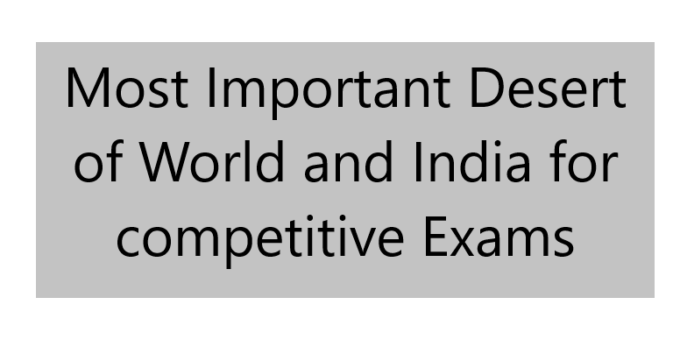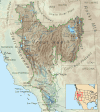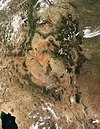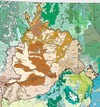
Most Important Desert of World and India for competitive Exams
Hello Aspirants,
World Deserts:
- Sahara Desert: Located in North Africa, it is the largest hot desert in the world, covering an area of about 9.2 million square kilometers.
- Arabian Desert: Situated in the Arabian Peninsula, it is the largest continuous sand desert in the world, spanning across several countries including Saudi Arabia, Oman, Yemen, and the United Arab Emirates.
- Gobi Desert: Located in East Asia, it stretches across northern China and southern Mongolia, covering an area of about 1.3 million square kilometers.
- Mojave Desert: Situated in the southwestern United States, primarily in California, it is known for its unique ecosystems and is the driest desert in North America.
- Atacama Desert: Located in South America, it stretches across parts of Chile and Peru, and is known as the driest non-polar desert in the world.
Indian Deserts:
- Thar Desert: Also known as the Great Indian Desert, it is the largest desert in India and spans across the northwestern part of the country, primarily in the state of Rajasthan.
- Cold Desert of Ladakh: Located in the northernmost part of India, in the region of Ladakh, it is a high-altitude desert characterized by cold temperatures and sparse vegetation.
- Kutch Desert: Situated in the state of Gujarat, it is a seasonal salt marsh desert that transforms into a saline wetland during the monsoon season.
- Deccan Thorn Scrub Forests: Although not a traditional desert, certain regions of the Deccan Plateau in central India have arid and semi-arid conditions, resulting in thorny scrub forests and savannah-like landscapes.
These are some of the prominent deserts in the world and in India. Each desert has its own unique characteristics, ecosystems, and cultural significance.
Download GK Notes
- Vajiram and Ravi Polity Handwritten Notes PDF
- Vision IAS Polity Notes PDF In Hindi
- laxmikant polity handwritten notes pdf in hindi Download
- Drishti IAS Indian Polity notes PDF in Hindi
- Indian Polity Handwritten Notes in Hindi PDF Download
- Vision IAS Indian Geography Notes PDF In Hindi
- Mahesh Barnwal Geography Book in Hindi
- Drishti IAS Indian Geography notes PDF in Hindi
- Ankur Yadav Handwritten Notes PDF Download
- Alok Ranjan Geography Handwritten Notes PDF Download
- Khan Sir History Notes PDF Download In Hindi
- Vision IAS History Notes PDF Free Download
- Drishti IAS Indian History Notes PDF In Hindi
- Modern History of India Notes PDF In English
- Indian history notes pdf download In Hindi
- History of Medieval India by Satish Chandra PDF Download
Most Important Desert of World and India for competitive Exams
Rank |
Name |
Type |
Image |
Area (km2) |
Area (sq mi) |
Location [note 1] |
Nation(s) |
|---|---|---|---|---|---|---|---|
1 |
Polar ice and tundra |
14,200,000[1] |
5,482,651 |
N/A |
|||
2 |
Polar ice and tundra |
13,900,000[1] |
5,366,820 |
||||
3 |
Subtropical |
9,200,000[1] |
3,552,140 |
||||
4 |
Subtropical |
2,700,000 |
1,042,476 |
||||
5 |
Subtropical |
2,330,000[2] |
899,618 |
||||
6 |
Cold winter |
1,295,000[1] |
500,002 |
||||
7 |
Subtropical |
900,000[3] |
347,492 |
||||
8 |
Cold winter |
673,000[1] |
259,847 |
||||
9 |
Subtropical |
500,000[4] |
193,051 |
||||
10 |
Cold winter |
492,098[4] |
190,000 |
||||
11 |
Subtropical |
453,248[4] |
175,000 |
Mexico and the United States |
|||
12 |
Cold winter |
350,000[4] |
135,136 |
||||
– |
Subtropical |
348,750[1] |
134,653 |
||||
13 |
Cold winter |
337,000[4] |
130,116 |
||||
14 |
Subtropical |
310,000[4] |
119,692 |
Mexico and the United States |
|||
15 |
Cold winter |
300,000[4] |
115,831 |
||||
16 |
Cold winter |
270,000 |
104,248 |
||||
17 |
Subtropical |
256,000 |
98,842 |
||||
18 |
Subtropical |
238,254 [5] |
77,220 |
||||
20 |
Subtropical |
200,000 |
77,220 |
||||
20 |
Temperate |
200,000 |
77,220 |
||||
21 |
Subtropical |
175,000 |
67,568 |
||||
22 |
Cool coastal |
160,000 |
61,776 |
||||
23 |
Subtropical |
150,000 |
57,915 |
||||
24 |
Subtropical |
146,000 |
56,371 |
||||
25 |
Mild coastal |
140,000[4] |
54,054 |
||||
26 |
Subtropical |
137,000 |
52,896 |
||||
27 |
Subtropical |
47,877 |
|||||
28 |
Subtropical |
100,000 |
38,610 |
||||
29 |
Cold winter |
83,139[4] |
32,100 |
Canada and the United States |
|||
30 |
Subtropical |
77,000[8] |
29,730 |
||||
31 |
Subtropical |
70,000 |
27,027 |
||||
32 |
Cold winter |
59,146 |
22,836 |
||||
33 |
Subtropical |
52,000[8] |
20,077 |
Tropic of Cancer and Tropic of Capricorn
The area between the Tropic of Cancer (23° N latitude) and the Tropic of Capricorn (23° S latitude) is known as the tropics or the low latitudes. It has the highest annual average temperatures on Earth. The Tropic of Cancer is a parallel that measures 23° N (or 23.5° N) and runs through Mexico, the Bahamas, Egypt, Saudi Arabia, India, and southern China. The Tropic of Capricorn measures 23° S (or 23.5° S) and runs through Australia, Chile, southern Brazil, and northern South Africa. The Tropic of Cancer and the Tropic of Capricorn were so named because of the particular constellations that the sun is in at the time of their respective solstices, or the time when the vertical
sun is the farthest north or south of the equator. The sun appears directly over the Tropic of Cancer during the Northern Hemisphere’s summer solstice and directly over the Tropic of Capricorn during the Southern Hemisphere’s summer solstice. Earth rotates on its axis, and at the same time, it revolves around the sun. Earth is tilted at an angle of 23.5°, which means that all locations on Earth do not receive the same amount of direct sunlight. The areas close to the equator receive the most direct sunlight and, therefore, have the hottest average
temperatures year-round. The North and South poles, the areas farthest away from the equator have extreme cold temperatures year-round. The polar regions have two defined seasons. Because of the tilt of Earth, polar areas— and the high latitudes in general—have twenty-four hours of sunlight in the summer and twenty-four hours of darkness in the winter. The farther a place is from the equator, the more pronounced the differences will be between summer and winter in terms of length of the days and nights.
Climate Zones: Arctic, Tropical, and Temperate
There are three main categories of climate—arctic (also known as polar), tropical, and temperate.
• The arctic climate is often referred to as the polar climate by geographers because the term polar makes it clear that the climate includes both the Arctic and Antarctic areas. Polar climates have cool to cold summers and cold to very cold winters. Temperatures average below 32°F year-round on the Antarctic and Greenland ice caps and drop to well below 0°F during the long, dark winter months. Precipitation is scant, averaging only a few inches each year, and most of it falls in the form of snow. A band of subpolar climate stretches across northern North America and Eurasia. Here, one gets short summers with average temperatures above freezing for two or three months; then the temperature plunges below freezing throughout the remainder of the year. Most of this region receives between five and ten inches of precipitation, with some areas receiving up to twenty inches. Snowfall can occur during any month.
Most Important Desert of World and India for competitive Exams
हारा (The Sahara Desert) – 90,65,000 किमी
Area and Countries:- नाइजर, सूडान, अल्जीरिया, चाड, लीबिया, माली, मिस्त्र, मोरक्को और Libya (North Africa), मारिटानिया, टयूनीशिया
ऑस्ट्रेलिया (Desert of Australia) – 15, 40,000 किमी
Area and Countries:- ग्रेट विक्टोरिया, ग्रेट सेण्ड्री, सिम्पसन, गिब्सन और स्टुअर्ट
गोबी (Gobi Desert) – 10,36,000 किमी
Area and Countries:- मंगोलिया और चीन
कालाहारी (Kalahari Desert) – 5,18,000 किमी
Area and Countries:- बोत्सवाना (विश्व का सबसे शीत मरूस्थल)
तकलामकान (Parlamakan Desert) – 3,27,000 किमी
Area and Countries:- सीक्यांग (चीन)
अरब (Arabian Desert) – 230,0000 किमी
Area and Countries:- सउदी अरब, यमन, सीरिया, नाफुद
सोनोरन (Sonoron Desert)
Area and Countries:- एरीजोना एवं कैलीफोर्निया, (USA & Mexico)
नामीब (Namib Desert) – 1,35,000 किमी
Area and Countries:- दक्षिण अफ्रीका (नामीबिया)
काराकुम (Karakum Desert) – 2,97,900 किमी
Area and Countries:- तुर्कमेनिस्तान
थार (Thar Desert) – 2,59,000 किमी
Area and Countries:- उत्तरी पश्चिमी भारत और पाकिस्तान
सोमाली (Somali Desert)
Area and Countries:- सोमालिया गणराज्य (अफ्रीका)
अटाकामा (Atacama Desert) – 1,05,000 किमी
Area and Countries:- उत्तरी चिली (दक्षिणी अमेरिका)
काजिल कुम (Kajil Kum Desert)- 233100 किमी
Area and Countries:- उज्बेकिस्तान, कजाखस्तान
दस्ते ए लुट (Squad A Booty Desert)
Area and Countries:- पूर्वी ईरान
मोहाबे (Moheave Desert)
Area and Countries:- दक्षिणी कैलीफोर्निया (USA)
दक्षिणी एशिया का सबसे बड़ा मरुस्थल कौन-सा है
Ans. थार
विश्व का सबसे शुष्क मरुस्थल कौन-सा है
Ans. अटाकामा
सहारा मरुस्थल कहाँ है
Ans. उत्तरी अफ्रीका में
कालाहारी रेगिस्तान कहाँ है
Ans. दक्षिणी-पश्चिमी अफ्रीका में
संसार का सबसे बड़ा मरुस्थल कौन-सा है
Ans. सहारा
गोबी मरुस्थल कहाँ स्थित है
Ans. मंगोलिया में
नूबियन मरुभूमि कहाँ स्थित हैं
Ans. सूडान में
संयुक्त राज्य अमेरिका(USA) में कौन-सा मरुस्थल फैला है
Ans. मोजेव
कालाहारी मरुस्थल किस देश में स्थित है
Ans. बोत्सवाना
विश्व के शीत मरुस्थलों को किस नाम से जाना जाता है
Ans. टुंड्रा
चट्टानी मरुस्थल का सहारा क्षेत्र में नाम है
Ans. हम्मादा
विश्व का सबसे बड़ा शीत मरुस्थल कौन-सा है
Ans. गोबी
“अल गे जीरा” रेगिस्तान किस देश में स्थित है
Ans. सूडान में
“पेटागोनिया मरुभूमि” किस देश में है
Ans. अर्जेंटीना
“रूब-अल-खाली” क्या है
Ans. सऊदी अरब का एक मरुस्थल
अल्जीरिया किस मरुस्थल में स्थित है
Ans. सहारा में
सोनोरान मरुस्थल कहाँ है
Ans. मैक्सिको में
अटाकामा मरुस्थल किस देश में है
Ans. चिली में
मरुद्वीप किससे संबंधित है
Ans. रेगिस्तान से
विश्व का मरुस्थल विहीन महाद्वीप कौन-सा है
Ans. यूरोप
More Related PDF Download
Maths Topicwise Free PDF >Click Here To Download |
English Topicwise Free PDF >Click Here To Download |
GK/GS/GA Topicwise Free PDF >Click Here To Download |
Reasoning Topicwise Free PDF >Click Here To Download |
Indian Polity Free PDF >Click Here To Download |
History Free PDF > Click Here To Download |
Computer Topicwise Short Tricks >Click Here To Download |
EnvironmentTopicwise Free PDF > Click Here To Download |
UPSC Notes >Click Here To Download |
SSC Notes Download > Click Here To Download |
Topic Related Pdf Download
pdfdownload.in will bring you new PDFs on Daily Bases, which will be updated in all ways and uploaded on the website, which will prove to be very important for you to prepare for all your upcoming competitive exams.
The above PDF is only provided to you by PDFdownload.in, we are not the creator of the PDF, if you like the PDF or if you have any kind of doubt, suggestion, or question about the same, please send us on your mail. Do not hesitate to contact me. [email protected] or you can send suggestions in the comment box below.
Please Support By Joining Below Groups And Like Our Pages We Will be very thankful to you.
- Facebook Page: https://www.facebook.com/onlyupsc/






























